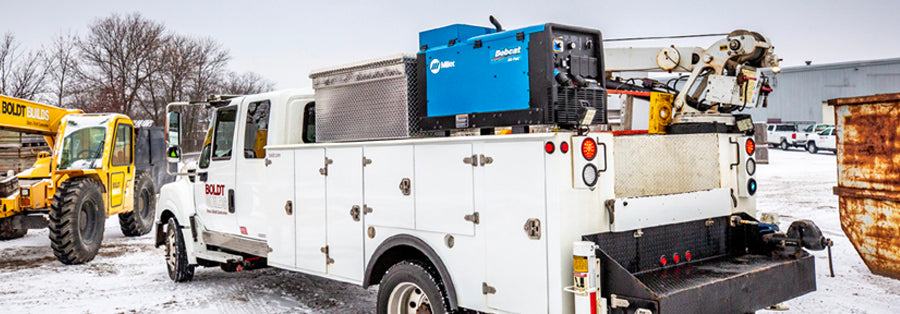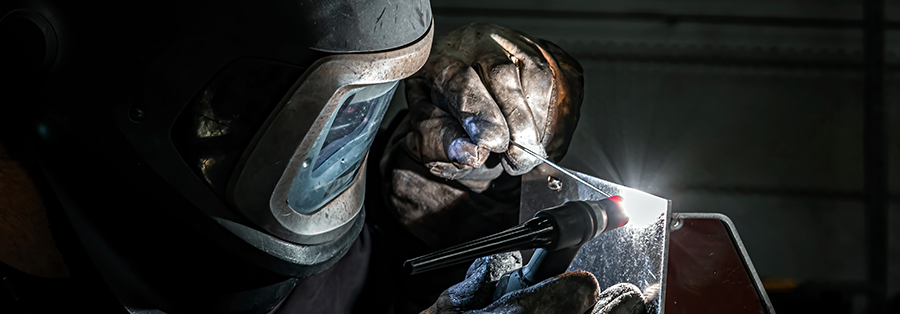Having a mobile welding solution can be a huge opportunity. Not being held down by the power grid allows you to take jobs anywhere. Is there a 250-volt socket at the job? Doesn’t matter, you’ve got your own power. Is the job site secured so you don’t have to worry about your tools being stolen overnight? Not a problem, your equipment drives home with you at the end of the day. For these reasons and more, having a vehicle with your own welder/generator can be incredibly enticing.
You know what’s not enticing? Finding out you’ve accidentally bent your truck frame from overloading it. There’s a very specific way to know exactly what type of equipment is best for your vehicle. In this article, we’ll show you exactly how to calculate what welder/generator is right for your mobile welding solution.
Vehicle Class & GVWR
Most reputable welding manufacturers (the only kind we offer at Welding Supplies from IOC) will provide very specific details about the weight of their welder/generators and the vehicle class suggested for hauling such a machine.
When calculating what your vehicle can handle, you’re first looking to figure out its Gross Vehicle Weight Rating (GVWR). This number represents the maximum allowed total weight of your vehicle and its cargo – in other words: the weight of the vehicle, any liquids, passengers and any equipment you’re hauling. The GVWR is not what your car currently weighs, it’s what the vehicle’s manufacturer has determined to be the maximum amount of weight your vehicle is rated to handle. Basically, this is the number we need to stay below. Your GVWR also determines your vehicle class.

Vehicle class gives you a quick estimate for which types of welder/generators you should be considering. There’s often some confusion on how this number is determined. Vehicle class is almost completely based on your vehicle's GVWR. Most welder/generator manufacturers suggest classes between 2 and 7 when hauling large equipment. Below is a breakdown of those classes based on GVWR.
Class 2: 6,001-10,000 Pounds
Class 3: 10,001-14,000 Pounds
Class 4: 14,001-16,000 Pounds
Class 5: 16,001-19,500 Pounds
Class 6: 19,501-26,000 Pounds
Class 7: 26,001-33,000 Pounds
To find out your vehicle’s GVWR as determined by the manufacturer, you have several options:
1. Most of the time, you can find your GVWR on a label on your driver’s side door jam. This is usually the easiest option.
2. You can also find your GVWR online, but you will have to know the trim of your vehicle model since different versions of the same model have different GVWRs.
Finding the Right Welder/Generator For Your Vehicle
Calculating the exact weight of your vehicle can be somewhat time-consuming, so often welding manufacturers will list the recommended vehicle class to haul that particular machine. Let’s look at the Miller Trailblazer 330 spec sheet below:

According to Miller, they recommend a vehicle class between a 3 and a 5 to transport this engine-driven machine. Simply by knowing your vehicle’s class, you can get an idea of which range of welder/generators you should be considering.
However, to know for sure if your vehicle can handle a specific engine drive, we’ll have to do the math. Essentially, we need to subtract your vehicle’s weight plus the weight of any cargo and passengers from the listed GVWR. It sounds a little complex but it’s actually quite easy. We’ll take you through the exact steps below.
As mentioned, first we need to find the “curb weight” of your vehicle. Most car makers will list this spec online. Make sure you’re looking at the curb weight and not the dry weight. Dry weight doesn’t include the added weight of any liquids. Since you need gas in your vehicle to actually drive it, we want the curb weight (the weight of your vehicle plus a full tank of gas and any other liquids).
Once you have that, the next step is to minus your curb weight from your vehicle’s GVWR. This tells you how much weight you have left for passengers, cargo and any modifications to the vehicle. For instance, a 2018 Ford Super Duty F350 has a GVWR of 14,000 lbs. This makes it a class 3 vehicle (although almost a class 4). This gives us a pretty quick idea that our F350 should be able to handle the Trailblazer 330, but let’s do the math:
The curb weight of the 2018 F350 is 6,714 pounds. If we take the listed GVWR, that’s 14,000 minus 6,714. That gives us 7,280 pounds left for any passengers, equipment or modifications to the vehicle. Ford actually says 7,180 (100 pounds less than the calculations), just to be safe.
You’ll probably want to make sure you can haul around a group of people in your truck without having to remove your equipment, so let’s account for 4 people at 250 pounds each (just to be safe). That’s 1,000 pounds out of our capacity, meaning if all we did was haul 4 people, we still have around 6,200 pounds left for any cargo. We also need to subtract any modifications done to the vehicle. For instance, if you’ve added an equipment rack, tool box, upgraded the suspension – anything that would not be stock with that vehicle. A lot of shops will add a label near your car’s GWVR label letting you know how to account for these modifications, but you might also have to do some estimating.
Finally, we can compare our leftover numbers and see what size of welder/generator will work with our vehicle. In the case of the Trailblazer 330, it weighs 400 pounds for the gas version and 611 pounds for the diesel version. In both cases, our Ford F350 will most likely have no issue with the Trailblazer (unless you’re already hauling a large amount of heavy equipment – which you should calculate as part of your cargo weight).
Here are some specs for our most popular engine-driven welders:




A Word to the Wise
When it comes to suggested vehicle classes, welding manufacturers tend to be a little overly cautious. In our example of the Trailblazer 330, you won’t always need a class 3 vehicle to haul around a 400-pound engine drive. That being said, the consequences of exceeding your GWVR can be pretty severe. They range from fines and traffic violations to damaging your vehicle. As such, it’s always better to give yourself a healthy buffer zone when it comes to your cargo capacity.
As mentioned above when you’re calculating the cargo weight of your vehicle, that needs to include toolboxes, tools and any other equipment. It’s not unheard of to have toolboxes that weigh between 1,000 and 3,000 pounds. If you’re not calculating the exact weight of everything inside your vehicle, it’s best to give yourself a good amount of breathing room. The last thing you want to do is underestimate and bottom out your vehicle.

Both the vehicle and the welder/generator you choose are important. So important, it’s critical to know you have an expert who can answer your specific questions. Unlike most online welding stores, our experts here at Welding Supplies at IOC are real, skilled people living right here in the US of A. We pride ourselves on having the best customer service in the entire industry, with experts here to answer any questions you have about which machine will be best for your situation. Check out our full list of welder/generators here and don’t hesitate to reach out using the chat feature on our site or call us at (866) 854-7380.





